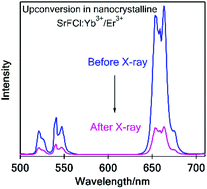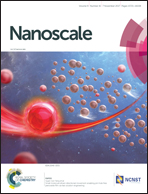Mechanochemically prepared SrFCl nanophosphor co-doped with Yb3+ and Er3+ for detecting ionizing radiation by upconversion luminescence
Abstract
We report a novel method for detecting ionizing radiation by employing the phenomenon of upconversion luminescence. Nanocrystalline SrFCl:Yb3+/Er3+ was prepared by ball-milling and characterized by powder X-ray diffraction (XRD), transmission electron microscopy (TEM), and X-ray photoelectron spectroscopy (XPS). The photoluminescence properties of nanocrystalline SrFCl:Yb3+, SrFCl:Er3+ and SrFCl:Yb3+/Er3+ before and after X-irradiation were investigated. The results demonstrate that both Yb3+ and Er3+ ions in the SrFCl host are reduced to their divalent state upon X-ray exposure. Under 980 nm infrared excitation, SrFCl:Yb3+/Er3+ nanocrystals displayed efficient upconversion luminescence. The upconversion luminescence intensity gradually decreased with increasing X-irradiation in a double exponential fashion with rate constants of k1 = 0.08 Gy−1 and k2 = 0.01 Gy−1. In comparison with other X-ray storage phosphors, the present system shows a much higher stability of stored information since it is not subject to photobleaching in the read-out process. This is the first report on detecting ionizing radiation by upconversion luminescence, with the potential for improved read-out performance over traditional storage phosphors. Possible applications of the present phosphor include bioimaging and in vivo cell-level X-ray dose monitoring.



 Please wait while we load your content...
Please wait while we load your content...